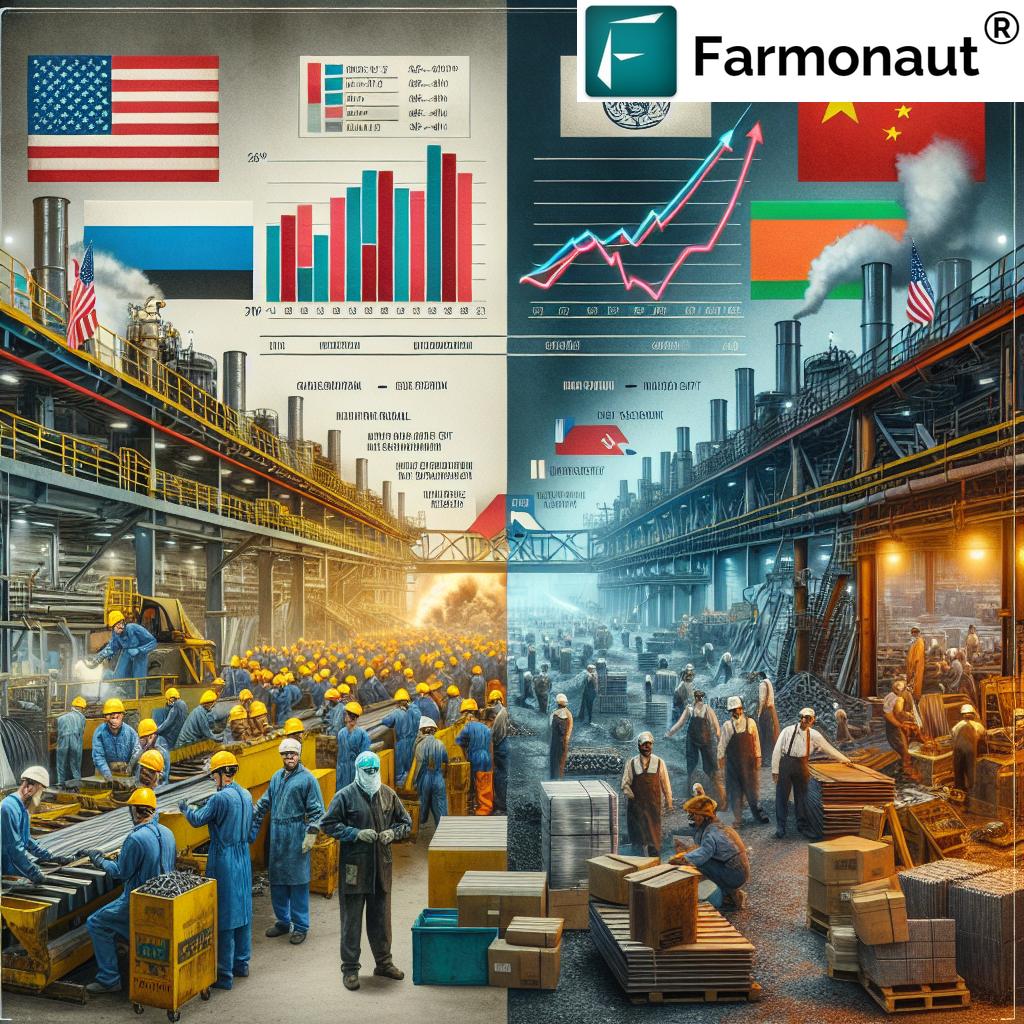Global Steel Tariffs Shake US Manufacturing: Economic Impact and Trade Policy Shifts
“Recent U.S. steel tariffs have led to a 25% increase in domestic steel prices, impacting manufacturing costs across industries.”
In today’s interconnected global economy, trade policies and tariffs play a crucial role in shaping the economic landscape. Recently, we’ve witnessed significant changes in U.S. trade policy, particularly concerning steel and aluminum imports. These shifts have sent ripples through various industries, affecting everything from manufacturing competitiveness to consumer prices. In this comprehensive analysis, we’ll explore the far-reaching implications of these tariff changes and their impact on the U.S. economy and global trade dynamics.
Understanding the New Tariff Landscape
On a momentous Monday, President Donald Trump announced sweeping changes to his 2018 tariffs on steel and aluminum imports. This decision marks a significant departure from previous policies, removing all exceptions and exemptions. The result? A flat 25% tax on all steel imports and an increase from 10% to 25% on aluminum imports. These changes represent a fundamental shift in U.S. trade policy, aimed at revitalizing domestic industries.
Trump’s declaration, “It’s time for our great industries to come back to America,” underscores the administration’s goal of enhancing U.S. manufacturing competitiveness. However, this move has not been without controversy, particularly given that top sources of steel imports to the U.S. include allies such as Canada, Brazil, Mexico, and South Korea.

The Global Trade Dynamics Shift
These tariff changes are part of a larger strategy to reset trade relationships globally. The administration’s efforts extend beyond steel and aluminum, with plans to align U.S. import taxes with those charged by other countries. This approach comes in the wake of an ongoing trade conflict with China, highlighting the complex nature of international trade relations.
While the intention behind these tariffs is to create a fairer trading environment, concerns are mounting about their potential impact on inflation and consumer pricing. Critics argue that higher tariffs could lead to:
- Increased costs for consumers
- Retaliatory measures from other countries
- Job losses in industries facing higher input costs
- Reduced competitiveness for U.S. companies in global markets
Benn Steil from the Council on Foreign Relations raises pertinent questions about the tangible benefits the U.S. might gain from these tariffs. He highlights that while the intent may be to protect U.S. interests, the reality could result in heightened costs for American consumers, dampened growth, and triggered price volatility.
Economic Implications and Market Reactions
The stock market’s reaction to these tariff changes has been mixed, reflecting the complex economic landscape:
- Steel companies saw a boost in share prices, with speculation suggesting increased profit margins.
- Companies like Cleveland-Cliffs and U.S. Steel reported significant gains.
- Firms dependent on steel and aluminum for manufacturing, such as General Motors, experienced declines in stock values.
This dynamic underscores a critical economic tension: while tariffs may advantage steel manufacturers, they can pose significant costs to broader sectors of the economy reliant on these raw materials.
“Economic analyses show that for every steel job created by tariffs, 16 jobs are lost in steel-using industries.”
Inflation Concerns and Consumer Impact
Public sentiment regarding inflation appears to be shifting. Recent data from the University of Michigan indicated an increase in inflation expectations, suggesting that consumers foresee rising prices as a pressing issue linked to the new tariffs. Economists are closely watching upcoming government inflation reports, anticipating broader price trends that could further support concerns about the inflationary impacts of these tariffs.
The potential for increased consumer prices is a significant concern. As manufacturing costs rise due to higher steel and aluminum prices, these increases are likely to be passed on to consumers. This could affect a wide range of products, from automobiles to household appliances, potentially impacting consumer spending and overall economic growth.
International Trade Barriers and Retaliatory Measures
As the U.S. implements these new tariffs, there’s growing concern about potential retaliatory measures from other countries. When imports are classified as national security threats, as is the case with these steel and aluminum tariffs, it opens the door for other nations to adopt similar barriers. This complicates global trade further and could lead to a cycle of increasing protectionism worldwide.
The concept of “fairness” in trade can vary significantly depending on perspectives. As countries respond to U.S. tariffs with their own trade barriers, we may see a reshaping of global trade flows. This could potentially disrupt established supply chains and force companies to reconsider their international operations.
Impact on U.S. Manufacturing Competitiveness
While the tariffs aim to boost U.S. manufacturing competitiveness, their actual impact is complex and multifaceted. On one hand, domestic steel and aluminum producers may benefit from reduced foreign competition. On the other hand, industries that rely heavily on these materials as inputs face increased costs, potentially reducing their global competitiveness.
Key factors to consider include:
- Potential job creation in steel and aluminum production
- Job losses in industries facing higher input costs
- Changes in global market share for U.S. manufacturers
- Long-term effects on innovation and industry development

Economic Analyses and Projections
Economic analyses of the tariff adjustments have emphasized their adverse effects on U.S. growth. However, the White House has countered these critiques, arguing that they don’t paint the full picture. The administration points to proposed tax cuts and regulatory rollbacks as factors that could offset potential negative impacts. However, without a detailed budget plan, comprehensive evaluation remains challenging.
Economists are closely monitoring several key indicators:
- GDP growth projections
- Employment rates in affected industries
- Trade balance figures
- Consumer price index trends
These metrics will be crucial in assessing the long-term economic impact of the tariff changes.
Global Trade Policy Shifts
The U.S. tariff changes are part of a broader shift in global trade policy. As nations grapple with economic challenges and seek to protect domestic industries, we’re seeing a trend towards more protectionist measures worldwide. This shift has significant implications for international trade agreements and the future of globalization.
Key aspects of this global policy shift include:
- Renegotiation of existing trade agreements
- Increased focus on bilateral trade deals
- Growing emphasis on national security in trade policy
- Potential restructuring of global supply chains
As these changes unfold, businesses and policymakers must adapt to a new, more complex international trade landscape.
Impact on Specific Industries
The effects of the steel and aluminum tariffs vary significantly across different sectors of the U.S. economy. Let’s take a closer look at how some key industries are being impacted:
| Industry Sector | Estimated Cost Increase (%) | Job Impact (Estimated Change) | Consumer Price Impact (Estimated %) |
|---|---|---|---|
| Automotive | 2.5 | -6,000 | 1.8 |
| Construction | 3.2 | -8,500 | 2.1 |
| Appliance Manufacturing | 4.0 | -3,200 | 2.5 |
| Energy | 1.8 | -2,500 | 1.2 |
This table illustrates the varying impacts across different sectors, highlighting the complex nature of tariff effects on the U.S. economy.
Policy Considerations and Future Outlook
As we look to the future, several key policy considerations emerge:
- Balancing protection of domestic industries with maintaining global competitiveness
- Addressing potential inflationary pressures
- Navigating international relations and trade partnerships
- Developing strategies to support industries negatively impacted by tariffs
The long-term success of these tariff policies will depend on how effectively the government can address these challenges while fostering economic growth and innovation.
Technological Innovations in Agriculture Amidst Economic Changes
While discussing the impact of steel tariffs on manufacturing, it’s worth noting how technological innovations are helping other sectors adapt to economic changes. In agriculture, for instance, companies like Farmonaut are revolutionizing farming practices with satellite-based solutions. These innovations can help farmers optimize their operations and reduce costs, potentially offsetting some of the economic pressures caused by tariffs in other sectors.
Farmonaut’s satellite-based farm management solutions offer real-time crop health monitoring, AI-based advisory systems, and resource management tools. These technologies can help farmers make more informed decisions, potentially leading to increased productivity and reduced input costs. In an era of economic uncertainty, such innovations could play a crucial role in maintaining agricultural competitiveness.
For more information on Farmonaut’s innovative solutions, visit their web app or explore their API for developers.


Consumer Awareness and Adaptation
As the effects of tariffs ripple through the economy, consumer awareness and adaptation become crucial. Consumers may need to:
- Stay informed about price changes in various product categories
- Consider alternative products or brands to manage costs
- Understand the reasons behind price increases
- Adjust budgeting and spending habits accordingly
Increased consumer awareness can lead to more informed purchasing decisions and potentially influence market dynamics in response to tariff-induced price changes.
International Relations and Diplomatic Considerations
The implementation of tariffs has significant implications for international relations. Key considerations include:
- Potential strain on relationships with allied nations affected by tariffs
- Implications for ongoing and future trade negotiations
- Impact on global economic cooperation and forums like the G7 and G20
- Potential shifts in geopolitical alliances based on trade policies
Navigating these diplomatic waters will be crucial for maintaining positive international relations while pursuing domestic economic goals.
Environmental and Sustainability Considerations
While the primary focus of tariff discussions often centers on economic impacts, it’s important to consider potential environmental implications:
- Changes in production locations may affect carbon footprints
- Shift in material sourcing could impact sustainability efforts
- Potential for increased focus on domestic recycling and resource efficiency
- Opportunities for innovation in sustainable manufacturing practices
These environmental factors should be part of the broader conversation about the long-term effects of trade policy changes.
Adaptation Strategies for Businesses
As businesses navigate this new economic landscape, developing effective adaptation strategies becomes crucial. Some key approaches include:
- Diversifying supply chains to reduce dependency on single sources
- Investing in efficiency improvements to offset increased input costs
- Exploring alternative materials or production methods
- Leveraging technology for better resource management and cost control
Companies that can successfully adapt to these changes may find new opportunities for growth and innovation in a challenging economic environment.
The Role of Technology in Economic Adaptation
In the face of economic challenges posed by tariffs, technology can play a crucial role in helping businesses adapt and thrive. Innovations in areas such as data analytics, artificial intelligence, and automation can help companies optimize their operations and reduce costs. For instance, in the agricultural sector, technologies like those offered by Farmonaut can significantly improve efficiency and productivity.
Earn With Farmonaut: Affiliate Program
Earn 20% recurring commission with Farmonaut’s affiliate program by sharing your promo code and helping farmers save 10%. Onboard 10 Elite farmers monthly to earn a minimum of $148,000 annually—start now and grow your income!
FAQs
- Q: How do steel tariffs affect consumer prices?
A: Steel tariffs can lead to increased costs for manufacturers, which may be passed on to consumers in the form of higher prices for products containing steel, such as automobiles, appliances, and construction materials. - Q: What industries are most affected by steel tariffs?
A: Industries most affected include automotive manufacturing, construction, appliance manufacturing, and energy sectors, which rely heavily on steel as a raw material. - Q: How do tariffs impact international trade relations?
A: Tariffs can strain relationships with trading partners, potentially leading to retaliatory measures and complicating international trade negotiations. - Q: Can tariffs help create jobs in the U.S.?
A: While tariffs may create jobs in steel production, they can lead to job losses in industries that use steel as an input, potentially resulting in a net negative effect on employment. - Q: How do businesses adapt to increased costs due to tariffs?
A: Businesses may adapt by diversifying supply chains, investing in efficiency improvements, exploring alternative materials, or passing costs to consumers.
Conclusion
The implementation of global steel tariffs and the resulting shifts in U.S. trade policy have created a complex and dynamic economic landscape. While aimed at rejuvenating domestic industries, these changes have far-reaching implications for manufacturing competitiveness, consumer prices, and international trade relations.
As we’ve explored, the impacts vary significantly across different sectors of the economy, creating both challenges and opportunities. Businesses, policymakers, and consumers must navigate this new terrain carefully, considering both short-term adjustments and long-term strategic planning.
The future of U.S. manufacturing and its position in the global economy will depend on how effectively these challenges are addressed. Continued monitoring of economic indicators, adaptation of business strategies, and ongoing policy evaluations will be crucial in shaping a resilient and competitive economic future.
In this evolving landscape, technological innovations, such as those offered by companies like Farmonaut in the agricultural sector, may provide valuable tools for businesses to adapt and thrive. By leveraging such technologies and remaining agile in the face of change, industries can work towards maintaining competitiveness in an increasingly complex global market.




